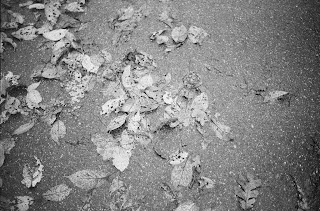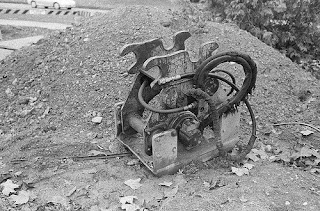 This trick has made its way around the web a few times, but it's still a pretty neat experiment that not everyone is aware of: developing film using instant coffee.
This trick has made its way around the web a few times, but it's still a pretty neat experiment that not everyone is aware of: developing film using instant coffee.The recipe calls for some instant coffee granules, washing soda, and water- that's it. For anyone who sees darkroom chemicals as mysterious black-box alchemy, it's a bit of a revelation that standard household chemicals can pull an image off a roll of film.
Instant coffee is available pretty much everywhere (I found an old container in the cupboard). Washing soda- not baking soda- used to be nearly impossible to find in Victoria, but I found some at both Fairway Markets and Thrifty Foods. It seems that it's been rediscovered as an economical and environmentally-friendly cleaner, which is good news for anyone interested in scrubbing up grease or developing film.
So here's the setup:
 We have an exposed film (Fuji Neopan 1600 exposed at ISO 800), a developing tank, coffee, and washing soda. Not shown, but also necessary: some fixer, and a dark place to load the film into the tank. You can use stop bath if you want, but since we're on an all-natural kick here, I've used plain water.
We have an exposed film (Fuji Neopan 1600 exposed at ISO 800), a developing tank, coffee, and washing soda. Not shown, but also necessary: some fixer, and a dark place to load the film into the tank. You can use stop bath if you want, but since we're on an all-natural kick here, I've used plain water.The developer mix is 5 teaspoons of coffee and 2 teaspoons of washing soda in 300ml of water, enough to fill the developing tank to the appropriate level. Fair warning: it smells like day-old pan grease.
Developing time is pretty long (20 to 30 minutes), and fixing time in water is not exactly speedy either (I gave it roughly 10 minutes), but the final results are actually kind of interesting.

The negatives themselves are heavily stained and extremely dark, and the images are low in contrast and fairly grainy, but they also have a look that's very much unlike what you'd get out of a modern purpose-made developer.

The look is pleasant and luminous, and the images display well both on paper and on screen. If you're at all interested in processing film, this is a method I'd highly recommend- not only for its novelty value, but for the very nice results.
Easy-to-follow instructions are available here on the excellent Photo Utopia blog, and the results from my own roll are here.

No comments:
Post a Comment